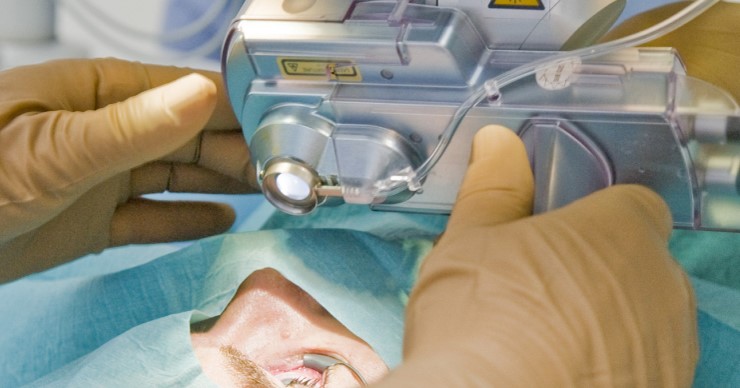People who have refractive lens exchange surgery often report that they experience very little pain during the procedure. This is due to the fact that the surgeon makes a small incision in the eye and then inserts a thin, flexible tube called a cannula. The surgeon then uses the cannula to remove the natural lens of the eye and replace it with an artificial intraocular lens.
What is Refractive Lens Exchange Surgery?

Source:facebook.com
Refractive lens exchange surgery is a type of surgery that is used to correct vision problems. The surgery is performed by removing the natural lens of the eye and replacing it with an artificial lens. This artificial lens is called an intraocular lens, or IOL. There are two main types of refractive lens exchange surgery: traditional open-sky surgery and microincisional surgery. Traditional open-sky surgery requires a large incision in the eye, while microincisional surgery requires a much smaller incision.
Refractive lens exchange surgery is generally safe and effective. However, as with any type of surgery, there are some risks involved. These risks include infection, bleeding, and inflammation. Additionally, although rare, it is possible for the artificial lens to become dislodged from the eye. RLE surgery is usually performed on an outpatient basis, which means that you will not need to stay overnight in the hospital. The procedure itself takes about an hour to complete. After the surgery, you will need to wear an eye patch for 24 hours. You will also be given eyedrops to help prevent infection and promote healing.
Most people experience little to no pain after refractive lens exchange surgery. However, some people may experience mild discomfort, such as soreness, itching, or burning. These symptoms should resolve within a few days. It is important to note that refractive lens exchange surgery is not covered by most health insurance plans. As such, you will likely need to pay for the surgery out of pocket. The exact cost of the surgery will vary depending on the surgeon you use and the type of artificial lens you choose.
How is the Surgery Performed?
Refractive lens exchange surgery is usually performed under local anesthesia, which numbs the area around your eye. You may also be given sedation to help you relax. The surgeon makes a small incision in the eye and then removes the natural lens. They will then place an artificial intraocular lens (IOL) in your eye. The IOL will be chosen based on your vision prescription. Once the IOL is in place, the incision is closed with stitches. The whole surgery usually takes less than 30 minutes.
The Different Types of Refractive Lens Exchange Surgery

Source:kraffeye.com
When it comes to refractive lens exchange surgery, there are different types that patients can choose from. This includes traditional surgery, which is typically more painful and requires a longer recovery time. There is also laser-assisted surgery, which is less painful and has a shorter recovery time. Patients should discuss with their doctor which type of surgery is best for them.
Pros and Cons of Refractive Lens Exchange Surgery
Types of refractive surgery are constantly evolving. One type that has gained popularity in recent years is refractive lens exchange surgery, also known as RLE. This procedure involves replacing the natural lens of your eye with an artificial one. The new lens can be customized to correct a wide range of vision problems, including nearsightedness, farsightedness, and astigmatism.
There are many benefits to RLE surgery, including the fact that it is usually less painful than other types of refractive surgery. Additionally, RLE can provide better vision results than LASIK or PRK and has a lower risk of complications. However, there are also some downsides to RLE surgery to consider. These include the high cost of the procedure and the fact that it is not yet FDA-approved in the United States.
If you are considering RLE surgery, be sure to talk to your eye doctor about all of your options and ask any questions you may have.
What to Expect During and After Refractive Lens Exchange Surgery?

source:youtube.com
When you come in for refractive lens exchange surgery, we will first numb your eye with an anesthetic. You will be awake during the surgery, but you will not feel any pain. We will then make a small incision in your eye and remove the natural lens. We will then replace it with an artificial intraocular lens.
After the surgery, you may experience some mild discomfort and your vision may be blurry. These side effects are temporary and should improve within a few days. Within a few weeks, your vision should be back to normal.
What are the Risks of Surgery?
When considering any type of surgery, it is important to weigh the risks and benefits. Refractive lens exchange surgery is a very safe procedure, but as with any surgery, there are potential risks involved. These include:
- Infection
- Bleeding
- Swelling
- Eye injury
- Vision loss
Fortunately, serious complications from refractive lens exchange surgery are rare. Most people who have the procedure experience little to no discomfort and achieve excellent results.
Alternatives to Refractive Lens Exchange Surgery
There are a few alternatives to refractive lens exchange surgery that may be worth considering if you’re not a fan of the idea of going under the knife.
– One option is to simply wear glasses or contact lenses to correct your vision. This is generally the least expensive option and has a very low risk of complications.
– Another alternative is to undergo corrective laser surgery instead of refractive lens exchange surgery. This type of surgery is non-invasive and can be completed in just a few minutes. It carries a slightly higher risk of complications than refractive lens exchange surgery, but it may be worth considering if you’re looking for a less invasive option.
– The final alternative is to have implantable contact lenses surgically inserted into your eyes. This option carries the highest risk of complications but can provide better vision than either glasses or contact lenses. It’s also the most expensive option, so it’s something to consider carefully before making a decision.
Conclusion

Source:horizoneye.com
Although some people may experience some discomfort after refractive lens exchange surgery, the overall procedure is relatively painless. The majority of patients report that they are able to return to their normal activities within a few days of surgery. If you are considering this type of surgery, be sure to consult with your doctor to see if it is right for you.

